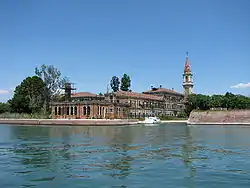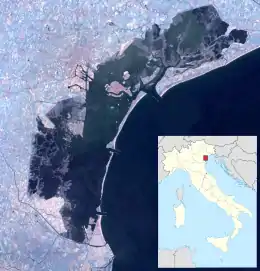Poveglia
Poveglia (Italian pronunciation: [poˈveʎʎa]) is a small island located between Venice and Lido in the Venetian Lagoon, northern Italy. A small canal divides the island into two separate parts. The island first appears in the historical record in 421, and was populated until the residents fled warfare in 1379. For more than 100 years beginning in 1776, the island was used as a quarantine station for those suffering the plague and other diseases, and later as a mental hospital. Because of this, the island is frequently featured on paranormal shows. The mental hospital closed in 1968, and the island has been vacant since.
 The hospital on Poveglia | |
 Poveglia (Island) | |
| Geography | |
|---|---|
| Coordinates | 45°22′55″N 12°19′52″E |
| Adjacent bodies of water | Venetian Lagoon |
| Administration | |
| Region | Veneto |
| Province | Province of Venice |
Visits to the island are prohibited, but various books and articles discuss visits by a writer and/or photographer. One of the latter described a place of "peace and serenity".[1]
History
The island is first mentioned in chronicles of 421, when people from Padua and Este fled there to escape the barbarian invasions. In the 9th century the island's population began to grow, and in the following centuries its importance grew steadily, until it was governed by a dedicated Podestà. In 1379 Venice came under attack from the Genoan fleet; the people of Poveglia were moved to the Giudecca.
The island remained uninhabited in the subsequent centuries; in 1527 the doge offered the island to the Camaldolese monks, who refused the offer. From 1645 on, the Venetian government built five octagonal forts to protect and control the entrances to the lagoon. The Poveglia octagon is one of four that still survive.
In 1776 the island came under the jurisdiction of the Magistrato alla Sanità (Public Health Office), and became a check point for all goods and people coming to and going from Venice by ship. In 1793, there were several cases of the plague on two ships, and consequently the island was transformed into a temporary confinement station for the ill (lazaretto); this role became permanent in 1805, under the rule of Napoleon Bonaparte, who also had the old church of San Vitale destroyed; the old bell-tower was converted into a lighthouse. The lazaretto was closed in 1814.
The island was used as a quarantine station from 1793 until 1814.[2] In 1922 the existing buildings were converted into an asylum for the mentally ill and later used as a nursing home/long-term care facility, until its closure in 1968. Afterwards, the island was briefly used for agriculture and then completely abandoned.
In 2014 the Italian state auctioned a 99-year lease of Poveglia, which would remain state property, to raise revenue, hoping that the buyer would redevelop the hospital into a luxury hotel.[3] The highest bid was from Italian businessman Luigi Brugnaro, (€513,000); he planned to invest €20 million euros in a restoration plan.[4] The lease did not proceed because his project was judged not to meet all the conditions.[5][6] Other sources suggested that the deal was annulled because the bid was too low.[7] Brugnaro initially fought the cancellation of the lease, but after he became mayor of Venice, he renounced any intentions to the island.[8]
In 2015, a private group, Poveglia per Tutti, was hoping to raise €25–30 million for a new plan to include "a public park, a marina, a restaurant, a hostel [and] a study centre" according to The Telegraph.[8] As of mid-2019, however, the island still sat vacant.[9]
Buildings and structures
The surviving buildings on the island consist of a cavana, a church, a hospital, an asylum, a bell-tower and housing and administrative buildings for the staff. The bell-tower is the most visible structure on the island, and dates back to the 12th century. It belonged to the church of San Vitale, which was demolished in 1806. The tower was re-used as a lighthouse.
The existence of an asylum on Poveglia seems to be confirmed by a sign for "Reparto Psichiatria" (Psychiatric Department) still visible among the derelict buildings, as photographed by Ransom Riggs in his May 2010 photo-essay documenting his visit to Poveglia.[10] However, there seems to be no evidence of an alleged prison.
A bridge connects the island on which the buildings stand with the island that was given over to trees and fields. The octagonal fort is on a third, separate island, next to the island with the buildings, but unconnected to it. The fort itself today consists solely of an earthen rampart faced on the outside with brick.
The island contains one or more plague pits. An estimate published by National Geographic suggest that over 100,000 people died on the island over the centuries and were buried in plague pits.[2] Another source, Atlas Obscura, provides an estimate of 160,000 people.[11]
News reports published in 2014/2015 confirmed that the building and rusting artefacts still existed.[12][13][14] The island contained dilapidated buildings including the church of St Vitale, a hospital, an asylum, and prison plus residential and office buildings.[15][8]
Photographer Mike Deere visited the island in 2014,[2] after paying a fisherman to take him there.[16][1]
Popular culture
Some time after the island had become a quarantine station for ships arriving at Venice in the 18th century, a plague was discovered on two ships. The island was sealed off and used to host people with infectious diseases, leading to legends of terminally ill Venetians waiting to die before their ghosts returned to haunt the island.[3]
A doctor allegedly experimented on patients with crude lobotomies. According to various reports, most recently by the Travel Channel, the doctor jumped from the bell tower in the 1930s after claiming he had been driven mad by ghosts.[3] He later died. Decades later, nearby residents claimed to still hear the bell, although it was removed many years earlier. That report, titled "Haunted History", also states that some restoration work had started recently but that "abruptly stopped without explanation".[17]
The island has been featured on the paranormal shows Ghost Adventures and Scariest Places on Earth.
Poveglia was also featured in the Alex Rider series by Anthony Horowitz as "Malagosto", the main assassin training centre for SCORPIA.
A dark Polish graphic novel by Roman Pietraszko (art) and Maciej Kur (script) titled "Żyjesz?" ("Are you alive?") is set on the island of Poveglia during the Plague and focuses on a sick girl and a boy trying to escape from the island while being hunted down by the plague doctors.[18]
An island inspired by Poveglia is the main location in the Sandman graphic novel Endless Nights, in the first story Death and Venice. The island is owned in the 18th century by a rich nobleman and alchemist, who finds a way to shield his palazzo, himself, and his guests from the ravages of time to repeat the same day over and over. The narrator visits the island as a boy and later as an adult, where (like Poveglia) it has been long since abandoned with a reputation of being haunted.[19]
Linda Medley's graphic novel Castle Waiting refers to Poveglia as 'The Island of No Return'. The character Dr. Fell was driven mad attempting to treat the plague victims. In the novel The Dark Temple by R.D. Shah, the island is one of the centers of the cult of Mithraism, with an underground Mithras temple (Mithraeum), in a cavern.[20]
See also
References
- https://books.google.ca/books?id=EoNWDAAAQBAJ&pg=PA161&dq=Poveglia+recent+visit+photographer+Deere&hl=en&sa=X&ved=0ahUKEwjlnOWWh8TjAhWCY80KHYp6DDMQ6AEIKjAA#v=onepage&q=Poveglia%20recent%20visit%20photographer%20Deere&f=false, Haunted Hospitals
- https://yourshot.nationalgeographic.com/photos/3536877/, Poveglia, Mike Deere
- Kington, Tom (15 April 2014). "'World's most haunted island' up for auction". The Telegraph. Retrieved 16 September 2014.
- https://www.businessinsider.com/haunted-italian-island-sold-2014-5, This Haunted Italian Island Just Sold For $704,000
- "How much? Haunted island near Venice Lido sells for €513,000". The Guardian. Agence France-Presse. 13 May 2014. Retrieved 23 May 2017.
- Sironi, Francesca (11 June 2014). "Poveglia, l'isolotto gioiello della laguna non-sarà svenduto". L'Espresso (in Italian). Rome: GEDI Gruppo Editoriale. Retrieved 23 May 2017.
- "Italy: Shock As Auction for the World's Most Haunted Island Is Called Off « PRIVATE ISLAND NEWS – Private islands for sale and for rent | Private island resort". www.privateislandnews.com. Retrieved 31 August 2020.
- Richardson, Nigel (15 December 2015). "Treasured island: How Venetians are saving Povegli". ISSN 0307-1235. Retrieved 31 August 2020.
- Mallinson, Harriet (23 April 2019). "Google Maps: Abandoned Italian island has VERY creepy past filled with horror stories". Daily Express. Retrieved 31 August 2020.
- "Strange Geographies: The Happy, Haunted Island of Poveglia". Mental Floss.
- https://books.google.ca/books?id=KrXxCwAAQBAJ&pg=PA52&dq=Poveglia+plague+pits&hl=en&sa=X&ved=0ahUKEwiF7vyphMTjAhXVLc0KHRDiDJoQ6AEIMTAB#v=onepage&q=Poveglia%20plague%20pits&f=false, Atlas Obscura, page 52
- O'Neill, Kara; Williams, Jack (31 October 2014). "Take a look at the real-life Shutter Island - one of the most haunted locations". mirror. Retrieved 31 August 2020.
- Aaron's Vlog: Poveglia Island, retrieved 31 August 2020
- "Poveglia - The Most Scariest Island in the World (+13) - YouTube". Retrieved 31 August 2020 – via YouTube.
- France-Presse, Agence (13 May 2014). "How much? Haunted island near Venice Lido sells for €513,000". The Guardian. Retrieved 31 August 2020.
- "Tailor Made Holidays to Greece, Cyprus, Azores & more | Sunvil.co.uk". Sunvil. Retrieved 31 August 2020.
- https://www.travelchannel.com/shows/ghost-adventures/articles/poveglia-islands-haunted-history, Poveglia Island's Haunted History
- "Żyjesz?". gildia.pl (in Polish).
- The Sandman: Endless Nights
- https://books.google.ca/books?id=6liGDwAAQBAJ&pg=PT333&dq=poveglia+dark+temple+rd+shah&hl=en&sa=X&ved=0ahUKEwjRq6eLg8TjAhWxds0KHYykBgAQ6AEIKjAA#v=onepage&q=poveglia%20dark%20temple%20rd%20shah&f=false, Chapter 31, The Dark Temple
External links
| Wikimedia Commons has media related to Poveglia. |
_as_seen_from_Lido.jpg.webp)
